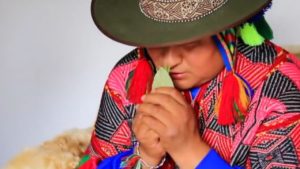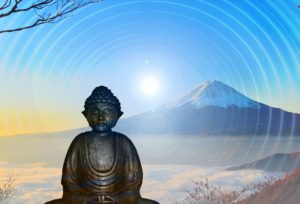
I’ve been working with Shamanic Journeys for healing and transformation for over 20 years. I think this modality is very promising for resolving personal issues that are resistant to traditional therapies.
In this article, I’ll cover
- What Shamanic Journeys are
- Case study: Therapeutic benefits and format of Shamanic Journeys
- Summarize a couple of great articles on the topic
- Four main types of Journeys: Educational, Therapeutic/Transformative (includes Soul Retrieval), Manifestation and Spiritual Communion
- Comparing Shamanic Journeys to better known modalities: hypnosis, NLP and counseling
- Shamanic Journeys and the modern Personal Success movement (a la Napoleon Hill)
What are Shamanic Journeys?
The Shamanic Journey is a semi-guided voyage where you use your imagination and have a transformational experience. Shamanic Journeys are very closely related to guided imagery therapy, guided meditation, and even hypnotherapy, as they all have similar therapeutic effects.
Shamanic Journeys originated with tribal indigenous cultures, where a tribe’s Shaman would journey on behalf of their patient to provide healing and bring their life into greater balance. Gradually as tribal ways have been shared with white culture, this modality was also shared. For in-depth reading on tribal Shamanism, my favorite site is Shamanism.org, which has a mission to preserve these ancient ways (please donate while you’re there!).
Shamanic Journeys are a modality for personal transformation, where you can learn new things about yourself and change parts of your personality and behavior that you don’t like very much. Because they are so diverse and powerful, I think of them as a profound way to quickly get ahead in life!
There are many different types of journeys depending on the intention and the way the journey is guided. Journeys, where your spiritual nature takes over and does more of the guiding, could give you self-knowledge and awareness; healing or clear blocks; help you connect with your spirit guides or have spiritual communion. Journeys that are more guided can help you learn new skills, open up your hidden talents and capabilities, or draw something new to your life that you would like to manifest.
It can take new journeyers some practice to reduce brain chatter and enjoy the experience. (One of the articles I summarize below has a great method of preparing yourself for more successful journey experiences.)
Watch the 8-min video version of this article
Case Study: Therapeutic Benefits and Format of Shamanic Journeys
When I first started experiencing Shamanic Journeys back in the ‘90s, it was in a therapeutic setting. I had gone through a breakup and I didn’t want to repeat the same mistakes; I wanted to be a better stronger person. My therapist Marilyn King in San Francisco received her Ph.D. in the therapeutic uses of Shamanic Journeys. She studied with Sandra Ingerman and Michael Harner, two of the greatest modern Shamans of our time (of the white people variety).

Journey Beginnings- Intention, setting sacred space, and going within
Every 2 weeks for a year I would arrive with an intention, something that was bothering me, such as feeling disconnected from the people around me. Marilyn would set sacred space and call the directions and we would journey together. She maintained psychic contact with me as I gave her a few bits of information about my experience.
Middle of the Journey – Guided by the Shaman or your Spirit
The journeys had a structured beginning and ending, with the middle undefined. I had the same starting place and similar guides, and usually, I visited the elemental altars and picked up gifts to carry with me on the journey, in case I needed them later. Then my guide would transport me to a location where an experience would unfold that was particular to my intention. In the journey when I felt disconnected, I was shown my place in the web of life, connected to every other conscious living thing here on earth and in the whole cosmos.
Over the different journeys, I went down deep into caves, looked into mirrors, opened special boxes of treasure, had conversations with lost parts of myself, met guides and received cleansing and healing from them, and had those healed parts of me step back inside me to re-integrate.
Journey’s End – Integration and Return
Then my guide would help me travel back out to my starting place, then I would gradually return to my body in the room. Sometimes I used the gifts I picked up at the beginning, sometimes I took them “back out” into the 3D world. After those journeys, the issue from my intention never bothered me again. (Compared to when I did traditional counseling or psychotherapy when the issue would need to be re-addressed, sometimes repeatedly. In my experience this is because processing in Shamanic Journeys occurs on all 4 levels: mental, emotional, physical, and spiritual, where traditional therapy addresses some, but not all, of these levels.)

Article Review: The Shamanic Journey by Shaman Links
The author(s) on this site are good-hearted and very knowledgeable, I enjoyed reading the articles on this site, and I like where they are coming from. This article defines a shamanic journey differently than I do, however, I like the way they describe the diversity of experiences a journeyer will have. I really like the description of the difference between a dream and a journey, that the experience inside of shamanic journey is much more visceral and real, you are there participating in the experience, more like a lucid dream.
While “soul flight” might be a traditional way to describe a shamanic journey, this doesn’t harmonize with my experience. Perhaps it’s a more modern perspective however I think we use different aspects of our consciousness in a journey. I often ask my students to call in their higher self as a guide, and sometimes we meet different parts of ourselves in the journey. So who is the journeyer compared to these other parts of ourselves? Actually, these are all different levels and parts of our own consciousness. I do agree with the author that there are spirit guides who arrive to help us in our journeys. These guides seem to come in response to our intention.
Article Review: How to Start Shamanic Journeying by Langston Kahn
I enjoyed Langston Kahn’s well-written article because it helps people get started successfully with this amazing modality. He includes a list of ways to prepare, such as a drum track, blindfold and pen, and paper. He mentions drumming; drumming has been proven to have therapeutic effects and traditionally Shamans use a rapid drumbeat that takes the listener into a trance. The trance state improves the likelihood of a powerful journey experience. It can also communicate the beginning and end of a journey. Langston gives some great tips on how to choose the internal starting place for your journey.
Types of Shamanic Journeys
What if you could learn a new set of skills while you are enjoying interesting and pleasant imagery? Based on research about play, we actually learn better when we’re having a good time.
In this section I describe 4 main types of Shamanic Journeys, though every journey experience unfolds in its own unique way.
Type 1: Educational Journeys
 Journeys are an excellent tool for learning new skills, particularly new skills that require internal changes.
Journeys are an excellent tool for learning new skills, particularly new skills that require internal changes.
I had the opportunity to collaborate with the director of an addiction recovery center, to create Shamanic Journeys based on her recovery skills curriculum. Many recovering addicts have issues with codependency and boundaries. They have little experience setting boundaries or feeling respected, so the new skill can be slow and difficult to learn. In this highly guided form of Shamanic Journey, the journeyer chooses a challenging person in their life and has a boundary conversation with them. They experience that person listening and agreeing, then later in the journey this person respects their requests in context, so they can experience being respected. Now that they’ve gained some experience, they have a better map for accomplishing boundary-setting externally.
Educational journeys build an internal experience of success that can be expanded into better external success.
 Type 2: Therapeutic and Transformational Journeys for Self-Awareness and Healing (aka Soul Retrieval)
Type 2: Therapeutic and Transformational Journeys for Self-Awareness and Healing (aka Soul Retrieval)
In these types of journeys, also called Soul Retrieval journeys, you can learn about yourself and heal different aspects of your personality you wish to change. Your experience in these journeys follows your intention. You can set an intention to meet a part of yourself that you feel out of touch with, or go on a hunt for the part of you that’s holding you back from your full potential.
In these journeys, you meet parts of yourself and have a dialogue similar to forms of counseling known as integrative parts psychology or voice dialog. You can learn what happened with that part of you, why it needed to leave. You can hear what that part of you wants from you now. When you’re willing to make promises to keep that part of you happy, it usually feels comfortable returning and re-integrating into you. When these parts of us return, we increase our effectiveness in life.
These journeys can be guided just in the beginning, letting the journeyer’s guides and higher self create the experience. Or they can be guided more fully where a specific dialog is encouraged. An example of a more fully guided soul retrieval journey would be having meetings with your masculine and feminine sides to encourage healing and balancing of your internal polarities.
There are also similarities between hypnosis and Shamanic Journeys (see section below). This sample hypnotic induction script is a guided journey in a natural setting for helping the client arrive in a suggestible altered state of consciousness in order to create their desired outcomes. Hypnotic induction causes the brain to enter into a suggestible Theta brain wave state where the therapist vocally implants positive ideas into the subconscious to assist their client with making changes such as breaking bad habits. This White Paper with the latest research on how hypnosis is resolving health issues means that Shamanic Journeys could also facilitate physical health and healing.
Type 3: Taking a Shamanic Journey to Manifest Something in your Life
A Shamanic Journey is a place where you can receive spiritual support for calling something new into your life. After you state your intention, the right guides come for the journey and facilitate experiences to fulfill it.
Your guides could take you to a realm where you can acquire new skills, meet the right people, or receive objects or blessings that help you get what you want in the outer world. An example of this is a journey for business folks to meet future clients where the journeyer sends out connections to the new clients and reels them in.
In every type of journey, the transformation is usually complete within the context of the journey. When you monitor your life in the days after the journey, you will feel different, and your life usually feels different too. If you stay in the willingness for changes to happen, you can see the positive benefits from the journey show up in your life.
Type 4: Journey to Enjoy a Spiritual Communion
 Traditional guides of Shamanic Journeys have a worldview that everything in life is spiritual. If you’re the type of person enjoys exploring your spirituality, this type of journey will excite you.
Traditional guides of Shamanic Journeys have a worldview that everything in life is spiritual. If you’re the type of person enjoys exploring your spirituality, this type of journey will excite you.
It’s common in every Shamanic Journey to invite guides to help you during the journey. These are spiritual guides, such as angels or animal allies, or even your Higher Self, the divine part of you who knows how the cosmos works.
These types of journeys are often characterized by feelings of wonder and bliss from communing with spiritual beings who have a higher vibration than most of us here in the third dimension.
In these types of journeys, you can meet and relate with your higher self and your guides and receive messages and blessings from them. These exchanges are memorable and meaningful, helping you understand yourself and make positive changes in your life. And it cures feelings of being alone in your life, you gain a sense of support.
An example is a guided journey where you meet your spirit animal allies. After meeting this guide in the journey, you can call upon them in your regular life and feel their companionship and support.
Comparing Shamanic Journeys with Hypnosis, NLP and Counseling
Above in this article, I talked about 4 types of Shamanic journeys – healing and transformation, education, manifestation, and spiritual communion.
The first three journey types have parallels to hypnosis and counseling. In this article, I’ll refer to Jungian integrative parts therapy used by counselors. (For a longer comparison of Shamanism and counseling, see the video of my 45-min talk, Shamanic Perspectives on Mental Illness and Addiction.)
 Shamanic journeys have a beginning, middle and end. The beginning of a journey is parallel to hypnotic induction, where the journeyer starts in a natural setting and then passes through several locations, then arrives at the destination where the experience in the middle of the journey begins to unfold.
Shamanic journeys have a beginning, middle and end. The beginning of a journey is parallel to hypnotic induction, where the journeyer starts in a natural setting and then passes through several locations, then arrives at the destination where the experience in the middle of the journey begins to unfold.
In hypnosis the practitioner uses guided meditation “induction” scripts to help the client ease into a calm light trance. The brain goes into a suggestible theta wave state and the practitioner speaks positive messages to the client that have a greater effect than in normal waking consciousness. Some hypnosis practitioners have clients imagine they are walking through a natural setting and arriving somewhere like a very peaceful lake, where the hypnotic suggestion begins.
The middle of the Shamanic journey is parallel to the phase of the hypnosis session after the induction, when the hypnotic suggestion begins. In the middle of a journey different experiences occur depending on the type of the journey (that also influence the power of the subconscious, see next section). The transformational/healing type of journey has a parallel to Jungian integrative parts therapy, because in this type of journey you could meet and have a healthy dialog with an unhappy part of you, then heal and integrate that part of you back in, very similar to the Jungian model.
Jungian Integrative Parts Therapy is where a counselor helps you identify different parts of your personality that have conflicting needs. Once you’re aware of these internal conflicts you can organize a dialog between your parts, and negotiate an agreement that brings them into harmony. With this internal conflict resolved, more of you is working towards the same goals in life and life gets easier. Counselors usually don’t guide clients into a trance or hypnotic state for this type of healing.
Neuro-Linguistic Programming (NLP) is a human capability field that has discovered that our brains are wired through our sensory experiences. When we walk through a few steps, we can re-wire our brains. A common approach in NLP is to first re-connect with an event or limitation then bring that limited self all the resources it needs to make an empowered choice. Then that newly empowered part is integrated with the present-time self. In every step of NLP, the practitioner guides the client in sensorial connections. NLP is very similar to Shamanic journeys because of the sensorial components and resourcing.
The end of a journey, counseling session and hypnosis session all ensure the client or journeyer has integrated the transformation and is ready for next steps. In a journey, spirit guides assist the journeyer to integrate the lessons of the journey.
 Shamanic journeys are unique of these four modalities because of the spiritual component. This points to the indigenous, tribal roots of this modality, as tribal cultures frequently see all disease and life issues as spiritual imbalances. At the beginning of the journey, journeyers call in a helper being or guide, often their own Higher Self, to be a knowledgeable companion who helps make decisions and facilitates experiences in the journey (such as bringing out the part of you with whom you need to have a discussion). Spirit helper beings facilitate healing and integration processes, find resources, and give blessings or attunements according to the intention of the journey. The spiritual forces in a Shamanic journey amplify the intensity of the experience, which often give the journeyer a stronger and more lasting impression. Stronger impressions appeal to the subconscious.
Shamanic journeys are unique of these four modalities because of the spiritual component. This points to the indigenous, tribal roots of this modality, as tribal cultures frequently see all disease and life issues as spiritual imbalances. At the beginning of the journey, journeyers call in a helper being or guide, often their own Higher Self, to be a knowledgeable companion who helps make decisions and facilitates experiences in the journey (such as bringing out the part of you with whom you need to have a discussion). Spirit helper beings facilitate healing and integration processes, find resources, and give blessings or attunements according to the intention of the journey. The spiritual forces in a Shamanic journey amplify the intensity of the experience, which often give the journeyer a stronger and more lasting impression. Stronger impressions appeal to the subconscious.
The subconscious loves narrative and repetition and remembers strong experiences. All these modalities help align your subconscious with your conscious mind and will. Journeyers consciously set intention for the journey, and then travel into fantastical internal realms that represent the subconscious. Shamanic Journeys are a highly effective way to tap the power of your subconscious because the journey has the elements to create the strongest impression on the subconscious mind compared to the other two modalities.
Shamanic Journeys and the Modern Personal Success Movement
Whether you like your life or not, the power of your subconscious is the part of you that created it!
Your subconscious either drives and motivates you, or stops you in your tracks. It either creates what you want, or what you don´t want, or a roller-coaster in between. You can look around at your life and figure out the health of your subconscious.
 The Modern Personal Success Movement teaches us to Align our Subconscious with our Conscious
The Modern Personal Success Movement teaches us to Align our Subconscious with our Conscious
If you want to be successful in life, it’s a heckuva lot easier after you align the power of your subconscious with your conscious desires and dreams. When your subconscious and your conscious are aligned, your conscious desires are perfectly communicated to the Superconscious, the cosmic fulfiller, instead of being miscommunicated by the subconscious. (The Superconscious is known by many names such as God, lifeforce energy, The Divine, cosmic consciousness, etc.) The Superconscious is responsible for giving us the magical results such as opportunities coming from out of the blue. Shamanic Journeys are a powerful and simple way to create this three-way alignment.
In this section I’ll talk about how Journeys tap the power of your subconscious and align it with your conscious, to help you create greater results in your life.
From the Change you want to make, Set an Intention for your Journey
 Setting intention before you take a journey is a key component of creating the most alignment. For example if you want to make healthier choices and find those choices really hard to maintain, set an intention for your Shamanic Journey to find the part of you who can make this much easier. In the journey you’ll meet the healthy chooser inside you and bring them back to the outer world. You´ll also receive other resources, blessings and attunements to make healthy choices much easier. Recall my case study with my early journeys…I usually only had to journey once to resolve an issue.
Setting intention before you take a journey is a key component of creating the most alignment. For example if you want to make healthier choices and find those choices really hard to maintain, set an intention for your Shamanic Journey to find the part of you who can make this much easier. In the journey you’ll meet the healthy chooser inside you and bring them back to the outer world. You´ll also receive other resources, blessings and attunements to make healthy choices much easier. Recall my case study with my early journeys…I usually only had to journey once to resolve an issue.
When you clearly state your intention before you take a Shamanic journey, your subconscious is paying attention, as well as all of your spiritual guides and helpers. Your subconscious gets cleared out and re-programmed through the narrative story of the journey. Your guides help you get what you need to bring your journey intention to fruition.
Shamanic Journeys Align our Subconscious with our Conscious so the Superconscious Gets our Message
Once your subconscious is clear it aligns with your conscious will and desires. When you express your desires with a clear subconscious, the Superconscious understands what you want and brings it to you, and even better. It is even possible to take a spiritual communion journey and spend time with the Divine and learn how to become an open channel for this manifestational energy to flow through you.
Shamanic Journeys are an easy fun way to support you in attaining your greatest desires in life, through healing, clearing and aligning the power of your subconscious with your conscious will.



Pingback: What are Spiritual Tools used in Shamanism? - Octavia Brooks
Pingback: #1 Shamanic Healing Technique - Soul Retrieval - Octavia Brooks
Pingback: Shamanic Journeys and the Power of your Subconscious - Octavia Brooks